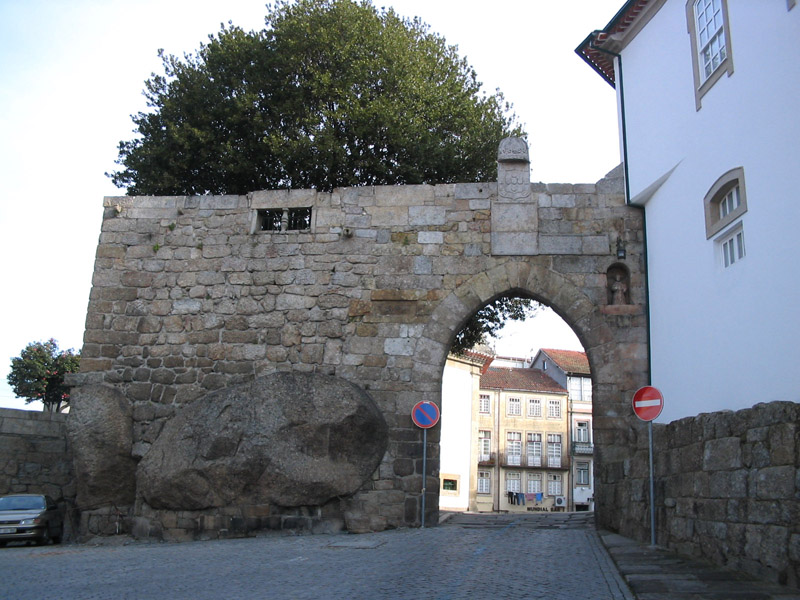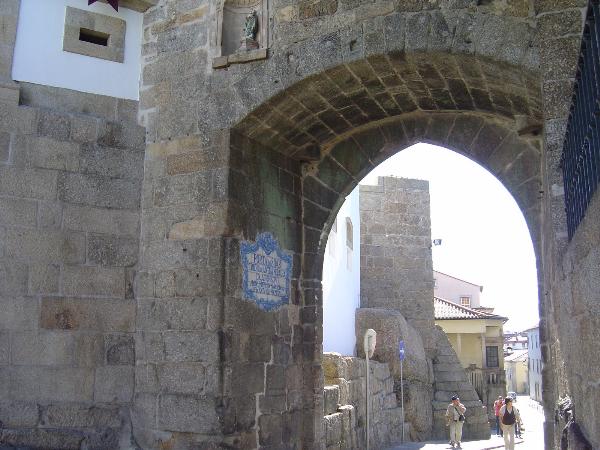[PT]PORTAS DE VISEU – 1
“PORTA DO SOAR”

As
Origens
Vestígios
descobertos, indiciam que a povoação da época neolítica que deverá
ter dado origem a Viseu, terá nascido no alto do monte onde se
situa a Sé.
Desde sempre se
reconheceu à sua localização, uma importância estratégica, que fez
de Viseu um ponto de passagem obrigatória entre o Norte e o Sul de
Portugal, bem como entre o litoral e o interior.
Os inúmeros vestígios
arqueológicos da época da dominação romana, encontrados na região,
de que se destacam sepulturas, moedas, marcos miliários, pontes e
principalmente estradas que aqui convergiam, denunciam que Viseu
seria, já nessa época um centro de grande
importância.
A denominada “Cava de
Viriato”, monumento octogonal com 2Km de perímetro, terá sido, ao
que tudo indica, um ponto de vigia e de defesa de um antigo
acampamento romano.
Sob o domínio dos
Visigodos, a cidade de Viseu é elevada a sede de
diocese.
Posteriormente, em
plena época da Reconquista Cristã da Península Ibérica, alternou
por diversas vezes entre o poder dos Cristãos e dos
Árabes.
No séc. IX foi
conquistada por Afonso
III, no final do século
seguinte por Almançore de novo, em definitivo,
por Fernando I, o Magno, em
1057.
A sua importância
estratégica tornou-a muito cobiçada por todos, tendo por isso, sido
alvo de sucessivos ataques destes povos, o que provocou a sua
inevitável destruição com a consequência da estagnação ou até
mesmo, recuo a nível urbanístico e
económico.
(fonte: artigo
da “profviseu.com”)
[EN]
DOORS
FOR VISEU - 1
"DOOR TO SOAR"
The
Origins
Traces discovered, show that the village of Neolithic season which
should have resulted in Viseu, was born on top of a hill where it
has Cathedral.
Since always been recognized for its location of strategic
importance, who made Viseu, a point of passage compulsory between
the north and south of Portugal, and between the coast and
inland.
The numerous archaeological remains from the era of Roman
domination, found in the region, of which graves, coins,
milestones, bridges and main roads that converged here, complain
that it would be Viseu, already at that time a centre of great
importance.
The so-called "Cava de Viriato," octagonal monument with 2Km of
perimeter, was, apparently, a point of watches and defence of a
former Roman camp.
Under the domination of the Visigoths, the city of Viseu is the
headquarters of high diocese.
Later, in full season of the Christian Reconquest of the Iberian
Peninsula, it alternated several times between the power of
Christian and Arab.
In the IX century was conquered by Afonso III, at the end of the
following century by Almançor and again, ultimately, by Fernando I,
the Great in 1057.
Its strategic importance became coveted it very for all, having
therefore, been white of repeated attacks of these people, which
caused its destruction with the inevitable consequence of
stagnation or even retreat at urban and economically. (Source:
article from "profviseu.com")
[PT]As Muralhas de
Viseu
S egundo o IPPAR,
“variam muito as opiniões
acerca das origens das muralhas viseenses, diversidade
fomentada pela escassez de informações arqueológicas. Dada a
antiguidade da cidade, tem sido consensual a atribuição de um
primitivo amuralhamento ao período romano, hipótese
confirmada recentemente por escavações arqueológicas
realizadas no Largo de Santa Cristina, mas cuja amplitude,
dimensão e perímetro se desconhecem. Também a cerca medieval
se apresenta bastante problemática. Tem sido frequente
considerar uma estrutura defensiva do burgo na viragem para o
século XII, mas, invariavelmente, faltam certezas.
egundo o IPPAR,
“variam muito as opiniões
acerca das origens das muralhas viseenses, diversidade
fomentada pela escassez de informações arqueológicas. Dada a
antiguidade da cidade, tem sido consensual a atribuição de um
primitivo amuralhamento ao período romano, hipótese
confirmada recentemente por escavações arqueológicas
realizadas no Largo de Santa Cristina, mas cuja amplitude,
dimensão e perímetro se desconhecem. Também a cerca medieval
se apresenta bastante problemática. Tem sido frequente
considerar uma estrutura defensiva do burgo na viragem para o
século XII, mas, invariavelmente, faltam certezas.
O que efectivamente sabemos acerca das muralhas de Viseu data da
Baixa Idade Média, mais concretamente do século XV, momento por
demais tardio face às condicionantes reconquistadoras que, com
certeza, motivaram o amuralhamento da localidade logo nos primeiros
tempos da nacionalidade, ou, ainda, antes.
No tempo de D. João I, trabalhava-se nas muralhas, mas a principal
informação é do reinado de D. Afonso V: em 1472, uma epígrafe
associada à Porta do Soar, indica que, nesse ano, o monarca ordenou
uma reformulação da estrutura defensiva, passando esta a integrar
as duas cercas antigas.
Epígrafe da Porta do
Soar:
“D. Afonso
Quinto Rey de Portugale dos Algarves daquem e
dalem marem Africa mandou cercar
esta nobre cidade de Viseu assi por
nobreza
e defensam della com prol
comum de seus Reynos…
1472”
Esta
informação é bastante importante, na medida em que certifica terem
existido duas linhas de muros, já considerados antigos pelos meados
do século XV. Neste sentido, é possível equacionar, pelo menos,
duas fases anteriores, que poderão corresponder, mesmo, a épocas
distintas de evolução urbana da própria cidade. Contudo, é possível
que tenham sido o resultado dos primeiros amuralhamentos medievais,
cuja eficácia foi dramaticamente testada no ciclo de Guerras
Fernandinas, na segunda metade do século XIV, quando Viseu foi, por
quatro vezes, atacada por exércitos castelhanos.
O que hoje resta destas muralhas data, assim, do século XV. Sob o
patrocínio da dinastia de Avis, edificou-se uma cerca poligonal, de
planta muito irregular (abraçando a própria fisionomia humanizada
da cidade), cuja correcta definição das suas linhas está hoje
bastante prejudicada pelas múltiplas alterações posteriores. Com
efeito, os poucos vestígios que restam são secções isoladas e
destituídas de ligações entre si, circunstâncias que impossibilitam
a reconstituição do seu traçado.
[EN]The Walls
of Viseu
According to the IPPAR, "the opinions vary widely about the origins
of the walls of
Viseu,diversity
fostered by the lack of archaeological information. Given the
length of the city, has been agreed to grant a
primitive walls
of the Roman
period, hypothesis recently confirmed by archaeological excavations
carried out at the Square of Santa Cristina, but whose scope, size
and perimeter are not known. Also to some medieval presents itself
very problematic. It has often been considered a defensive
structure of the village at the turn for the XII century, but,
invariably, there are certainties.
What actually know about the walls of Viseu date of Lower Middle
Ages, specifically the fifteenth century, when all too late regains
respond to that, of course, led the walls town of the early days of
nationality, or before.
At the time of D. John I, worked on the walls, but the main
information is the reign of King Afonso V: in 1472, a title
associated with the door of Soar, indicates that in that year, the
monarch ordered an overhaul of defensive structure, moving it to
integrate the two fences old.
Citation of Port
Soar:
“D. Afonso Quinto Rey de
Portugale dos Algarves daquem e dalem
marem Africa mandou cercar
esta nobre cidade de Viseu assi por
nobreza
e defensam della com prol
comum de seus Reynos…
1472”
This information is very important in
that it certifies have been two lines of walls, already
considered old by the mid-fifteenth century. In this sense,
it is possible to consider at least two previous phases,
which can match even the different seasons of urban evolution
of the city. However, we may have been the result of the
early medieval walls, whose effectiveness has been
dramatically tested in the cycle
of Fernandinas’Wars in the second half of the
fourteenth century, when Viseu was, for four times, attacked
by Spanish armies.
What now remains of these walls date, thus, the fifteenth century.
Under the sponsorship of the dynasty of Avis, is built around a
polygonal, plant very irregular (embracing the very humane face of
the city), whose proper definition of its lines today is quite
undermined by multiple subsequent amendments. Indeed, the few
traces that remain are isolated and
don’t havesections of links between them,
circumstances that make it impossible to reconstitute its
route.
[PT]A Porta do
Soar
Das sete portas
primitivas, restam apenas duas, e das torres originais quase
nada se conserva. As fases de destruição da muralha de Viseu
estão ainda por esclarecer convenientemente, na medida em que
parecem ter existido obras na época moderna, como o prova a
lápide de 1646 associada à Porta dos Cavaleiros. Ao que tudo
indica, o seu desmantelamento iniciou-se logo no século XVI,
aquando da ampliação do Paço episcopal. Mais tarde, em 1844,
a própria Câmara Municipal ordenou a demolição das antigas
portas, recapitulando-se, em Viseu, um processo entendido
como moderno e que caracterizou a actuação de alguns
municípios oitocentistas nacionais.

A Porta do
Soar, ou de São Francisco, é o
principal elemento remanescente. De arco ogival e com um pequeno
troço adossado, foi o eixo fundamental de circulação da cidade,
onde os construtores colocaram a epígrafe que data a construção do
reinado de D. Afonso V e um brasão com as armas nacionais. No
interior, um pequeno nicho contém ainda uma imagem do santo tutelar
da Porta, característica comum às principais entradas das
fortalezas tardo-medievais. A importância e o prestígio deste local
fez com que, anexa à porta, séculos mais tarde, se construísse uma
das mais interessantes casas civis barrocas de Viseu, o Solar dos
Melos, cujo impacto urbanístico e simbólico levou mesmo a que a
velha Porta do Soar passasse a ser conhecida como Arco dos
Melos. (fonte:
www.Ippar.pt)
[EN]The Door
of Soar
Of the seven original gates, only two
left, and the original towers almost nothing is preserved.
The stages of destruction of the wall from California are
still unclear properly in that it works seem to have existed
in modern times, as witnessed by the tombstone of 1646
associated with the Door of the Knights. It seems that the
dismantling started up once in the sixteenth century, when
the expansion of the Episcopalpalace. Later in 1844, the very City
Council ordered the demolition of old doors, summarising, in
Viseu, a process seen as
modernand that characterised the behaviour
of some nationals’ municipalities
of eighteen century.
The Door of
Soar, or San Francisco, is the main
element remaining. From
ogivalarc and with a short
section rounded, was the cornerstone of movement of
the city, where the builders placed the aforementioned date
that the construction of the reign of King Afonso V and a
coat with the national weapons. Inside, a small niche also
contains an image of the saint protect the port, a
characteristic common to the main entrances of late medieval
fortresses. The importance and prestige of this place has
caused, attached to the door, centuries later, if build one
of the most interesting houses of civilians Baroque Viseu,
Solar of Melos, whose urban and symbolic impact has led even
to the old port of Soar move to be known as Arc of
Melos. (Source:
www.Ippar.pt)
[PT]A
cache
As
coordenadas iniciais vão levá-lo à Porta do Soar. Junto a esta
porta, no largo Pintor Gata, existem uma capela e uma pequena
fonte.
1)
Qual a data referida na capela? (será abcd)
2)
Qual a data referida na fonte? (será efgh)
As
coordenadas finais da cache são encontradas:
1)
Subtraindo às décimas da latitude (ef+e+h)
2)
Somando às décimas da longitude (a+b+c+d)
[EN]The
cache
The
initial coordinates will take you to the Port of Soar. Next to this
door in broad Painter Gata, there are a chapel and a small
fountain.
1) What is the date mentioned in the chapel? (will be abcd)
2) What is the date mentioned in the source? (will be efgh)
The final coordinates of the cache are found:
1) subtracting the tenths of latitude (ef+e+h)
2) Adding to tenths of longitude (a+b+c+d)